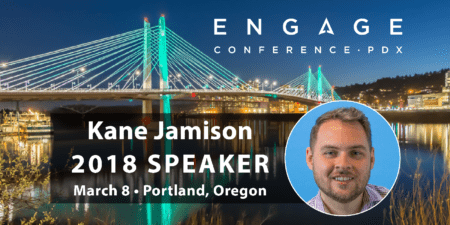Kane Jamison will be speaking on Content Marketing at Engage 2018, which will take place March 8th, 2018 in Portland, Oregon. For more information or to purchase tickets, please click here.

1) Please give us your background and let us know what you do for a living.
I’m the founder of Content Harmony, a content marketing agency based in Seattle. We primarily work with eCommerce, software, and consumer brands to build content marketing programs that are heavily driven by results from PR, paid social media, and SEO.
2) What is the prospective ROI of Content Marketing?
The right piece of cornerstone content can be a brand asset that lasts generations, and can even have the potential to become new revenue streams. So, the range of ROI is limited only by your imagination and elbow grease.
But, it’s important to focus on what your goals are. Content Marketing is not a channel like search or social and can’t be measured the same way. If you want content to produce conversions, you need to focus on content that supports that goal. Conversion-oriented content marketing will be much different than PR-oriented content, or content designed for long tail search, or content designed to drive a click from a social feed or email inbox. We approach all of those goals with different mindsets and formats and topics that match the end audience. Once you pin down the real goals behind the content marketing efforts you’re undertaking, you’ll have a much better idea how to measure the results of what you’re doing.
3) How do you advise businesses as to producing content that can meet concrete business objectives?
You really need to know what those objectives are, but, once you’ve gone through that process, the trick becomes identifying what topics, formats, and promotion mix will achieve those goals, and then testing them.
It can take longer to optimize content efforts than a PPC campaign, but PPC split testing frameworks are an effective mindset to use when working on building a content program. In a PPC campaign you would build lots of creative to test and build a number of ad groups with different audiences and keywords. With editorial content you can run a similar approach early on when you don’t know what is going to drive results: build a batch of content with varying topics and formats, promote them all on various channels to your audiences, see what works better, and then refine for your next quarter or year.
So, start with a content mix that seems to fit what your customers would expect, and test lots of variations. It’s essential to make sure that you’re balancing your efforts between content creation and promotion, too. An easy place to start is dedicating your time and budget 50/50 between the two. If you have 1 FTE working on content marketing, that person should divide their time evenly. Whatever your budget is, put half into content creation and half into promotion. We find that paid social ads, PR & outreach, and email marketing are all highly effective content promotion methods to focus on in most situations.
Finally – have a realistic view of the time frame to observe results. Most people have unrealistic visions for what content marketing can do for their brand in the short term, and greatly underestimate what content marketing can do for their goals in the long term. Give your team quarterly and annual goals, but expect it to take 6-12 months for a program to come close to break even, and typically 18+ months to earn a similar cost-per-acquisition or cost-per-sale to your more established channels, like PPC or other direct response marketing efforts.
Todd Mintz knows PPC…knows Social Media…knows SEO…knows Blogging…knows Domaining…and knows them all real well. He runs growth marketing for )and is also a Director & Founding Member of SEMpdx: Portland, Oregon’s Search Engine Marketing Association, and he can be found here on Twitter and Facebook.
